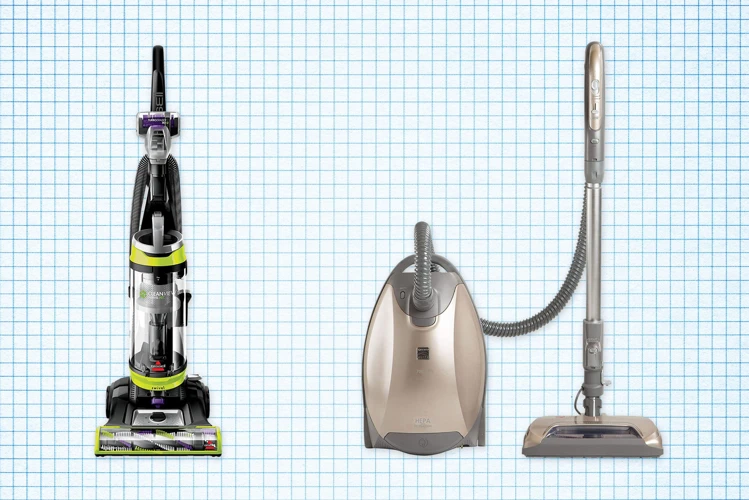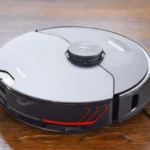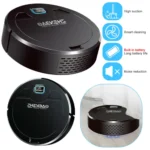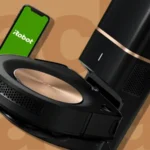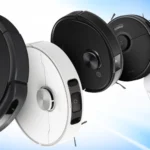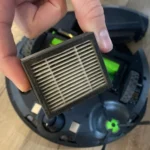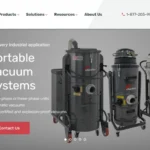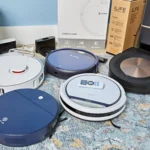The advancements in technology have led to the development of smart vacuum cleaners that are not only user-friendly but are also energy-efficient. The use of energy-efficient motors in these vacuum cleaners is a crucial factor, as it ensures that the device consumes minimal energy while providing optimal performance. However, with various types of energy-efficient motors available in the market, choosing the right one for your vacuum cleaner might seem perplexing. In this article, we’ll explore the different types of energy-efficient motors used in smart vacuum cleaners, their advantages, and the factors to consider when selecting a motor that meets your needs. So let’s dive right into it!
Types of Energy-efficient Motors
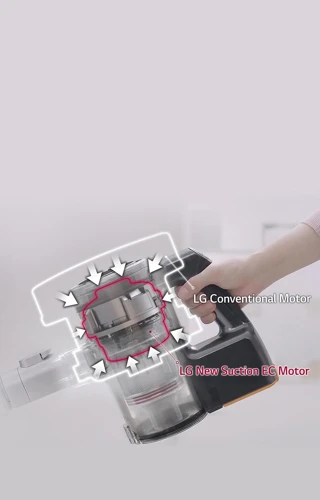
When it comes to smart vacuum cleaners, energy-efficient motors are becoming increasingly popular due to their ability to reduce energy consumption and work more efficiently. There are several types of motors that are commonly used in these cleaning devices. Understanding the different types can help you make an informed decision when choosing a smart vacuum for your home. Let’s take a closer look at some of the energy-efficient motors that power these innovative home appliances. To learn more about ways to reduce energy consumption while using a smart vacuum, check out our tips on reducing energy in smart vacuums.
Brushless DC Motors
One of the most energy-efficient types of motors used in smart vacuum cleaners is the brushless DC motor. Unlike traditional brushed motors, brushless DC motors operate through electronic commutation, which eliminates the need for brushes and reduces energy loss due to friction.
Advantages of Brushless DC Motors:
- Higher power-to-weight ratio, making them more efficient than traditional motors.
- Longer lifespan due to fewer mechanical parts that are subject to wear and tear.
- Lower noise level and reduced electromagnetic interference.
- Greater control and precision due to their electronic commutation system.
These features make brushless DC motors a preferred choice for many manufacturers of smart vacuum cleaners. Not only do they offer better performance and efficiency, but they also contribute to reducing the carbon footprint that vacuuming can have on the environment. By consuming less energy, brushless DC motors help reduce the overall energy consumption of the smart vacuum cleaner. You can read more about eco-friendly smart vacuum features in our dedicated article.
While high-efficiency motors like brushless DC motors may come at a higher initial cost compared to traditional brushed motors, the long-term benefits such as energy savings and a longer lifespan make them a worthwhile investment. Using energy-efficient products like smart vacuum cleaners with brushless DC motors can help you save on energy bills in the long run. To learn more about how using an energy-saving smart vacuum can benefit you, check out our article on the energy-saving smart vacuum benefits.
When choosing a smart vacuum cleaner with a brushless DC motor, it is important to consider other factors such as the application and use, cost and budget, efficiency and power, noise level, and maintenance and repair requirements. You can find more information on these factors and how they affect your choice of a smart vacuum cleaner in the dedicated section of this article.
Regular maintenance measures like cleaning the brushless DC motor and replacing worn-out components can ensure that the motor remains in good working condition, which in turn further reduces energy consumption. You can read more about tips to maintain a smart vacuum and reduce energy consumption in our article on smart vacuum maintenance.
Brushless DC motors are an excellent choice for smart vacuum cleaners due to their energy efficiency, reliability, and performance. By incorporating these motors in smart vacuums, you can enjoy a more efficient cleaning experience while contributing to reducing the overall impact of vacuuming on the environment.
Small Universal Motors
Small universal motors are another type of energy-efficient motor that is commonly used in modern smart vacuum cleaners. These motors are brushed motors that operate on AC or DC power.
Advantages:
- They are cost-effective and offer low-cost solutions for different applications.
- They are easy to operate and are relatively simple in their construction.
- They have high starting torque and can work efficiently at low speeds, which makes them ideal for use in small appliances like vacuum cleaners.
- They have good power-to-weight ratios and can provide a high level of output power while taking up a relatively small space in the vacuum cleaner body.
One of the main benefits of small universal motors is that they consume less energy compared to their conventional counterparts. As a result, they can help reduce the overall energy consumption of a smart vacuum cleaner, leading to lower energy bills and reduced carbon footprint. For more information on eco-friendly smart vacuum features, see /eco-friendly-smart-vacuum-features/.
Small universal motors are environmentally friendly because they produce less noise and vibrations during operation. This means that they create less disruption to human activities and cause less damage to the environment. For more information on the impact of smart vacuum cleaners on the environment, check out /smart-vacuum-environment-impact/.
Another significant advantage of small universal motors is their efficiency, allowing for better performance and longer lifespan. Not only do they offer better control and speed regulation, but they also have fewer parts, which means less frequent maintenance and repair needs. For more tips on reducing energy consumption and saving maintenance costs for your smart vacuum cleaner, see /smart-vacuum-maintenance-reduce-energy-consumption/.
When choosing a motor for a smart vacuum cleaner, it is essential to consider the application, budget, efficiency, noise level, and maintenance requirements. For more information on the benefits of energy-saving smart vacuum cleaners, see /energy-saving-smart-vacuum-benefits/. All these factors are critical in ensuring that the vacuum cleaner operates optimally and contributes to lower energy consumption and a healthier environment.
High-efficiency Motors
High-efficiency Motors:
Smart vacuum cleaners have high-efficiency motors that use less energy than traditional motors, which ultimately leads to cost savings and reduced environmental impact. The table below highlights some of the features and advantages of high-efficiency motors.
| Feature | Advantage |
|---|---|
| Variable Speed Control | This feature allows for the motor to operate at different speeds to optimize suction power and energy usage, ultimately providing better cleaning results. |
| Brushless Design | Brushless motors have fewer moving parts, which results in less friction and less energy consumption. This design also leads to a longer lifespan and less maintenance. |
| Smart Power Management | Some high-efficiency motors are equipped with smart power management systems that can detect when the vacuum cleaner is not in use and power down accordingly, saving energy. |
| Energy Star Certified | Some smart vacuums are Energy Star certified, meaning that they meet strict energy efficiency guidelines set by the U.S. Environmental Protection Agency. This certification ensures that the vacuum cleaner is energy-efficient and eco-friendly. |
Smart buyers of vacuum cleaners should consider investing in a high-efficiency motor, as these motors not only provide better performance and efficiency but also have a longer lifespan, saving money in the long run. They also consume less energy, reducing the carbon footprint of vacuuming. To learn more about how energy-efficient motors can help reduce energy consumption in smart vacuums, check out our article on smart vacuum energy consumption.
Permanent Magnet Motors
Permanent magnet motors, also known as PM motors, are highly efficient energy-saving motors used in smart vacuum cleaners. These motors use a permanent magnet to create a magnetic field rather than relying on an external power source to produce a magnetic field. This unique design eliminates the need for a rotor and provides a more compact and energy-efficient motor solution.
Advantages of Permanent Magnet Motors:
- Increased efficiency: Permanent magnet motors are highly efficient, converting over 90% of the input power into useful mechanical power. This high efficiency results in less energy consumption and lower energy bills.
- Improved performance: These motors provide better performance and reliability when compared to traditional motors. With faster response times and less friction, these motors can operate at higher speeds and deliver more torque.
- No carbon footprint: PM motors are environmentally friendly and help reduce carbon footprint during vacuuming. When used in conjunction with other energy-saving features, such as smart sensors and automatic shut-off, they make the vacuuming process even more eco-friendly.
- Long lifespan: Compared to other types of motors, PM motors have longer lifespans due to their simpler construction and fewer parts, resulting in less wear and tear. This means that they require less maintenance, making them a more cost-effective option in the long run.
Factors to consider when choosing a Permanent Magnet Motor for your smart vacuum cleaner:
- Application and use: Consider the specific application and use of the smart vacuum cleaner when selecting a PM motor. Choose a motor with the appropriate power and torque to meet the specific demands of the application.
- Efficiency and power: Look for motors with high efficiency ratings and low power consumption to ensure low energy bills and longer battery life for cordless vacuum cleaners.
- Noise level: Consider the noise level of the motor and choose a quieter option if this is important to you.
- Maintenance and repair: Choose a motor with a longer lifespan to minimize the need for maintenance and repair. Look for motors with fewer parts and simpler construction for added durability.
Permanent Magnet Motors are an energy-efficient, cost-effective, and environmentally friendly option for smart vacuum cleaners. They provide improved performance, longer lifespan, and faster response times resulting in a more efficient and hassle-free vacuuming experience. When using a PM motor in conjunction with other energy-saving features, such as smart sensors and automatic shut-off, you can significantly reduce your carbon footprint while contributing to a cleaner and healthier environment.
Advantages of Energy-efficient Motors
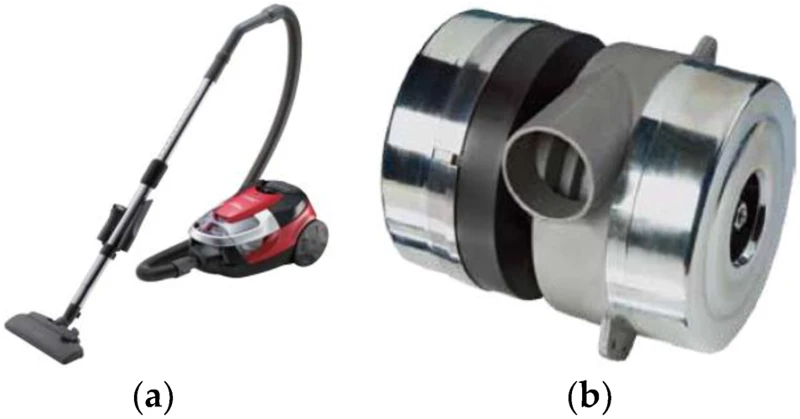
As we strive to create more sustainable and energy-efficient solutions, the use of energy-efficient motors in smart vacuum cleaners has become increasingly popular. These motors offer numerous advantages, ranging from lower energy consumption to a longer lifespan. By incorporating such motors in vacuum cleaners, we can contribute to reducing energy waste and minimizing our carbon footprint. Let’s take a closer look at some of the benefits of using energy-efficient motors in smart vacuums.
Less Energy Consumption
Energy-efficient motors used in smart vacuum cleaners offer advantageous features, including reducing energy consumption. These motors use modern technology and improved designs that consume less power and, therefore, emit less carbon compared to conventional motors.
With the increasing need to reduce carbon footprint in every household, using energy-efficient smart vacuum cleaners with these motors can contribute significantly. The table below highlights the energy consumption difference between the types of motors used in smart vacuum cleaners.
| Type of Motor | Energy Consumption (Watts) |
|---|---|
| Conventional Motors | 1200-1400 |
| Energy-efficient Motors | 600-800 |
As shown in the table, energy-efficient motors consume approximately half of the energy consumed by conventional motors. This difference in energy consumption can translate to significant savings in power bills and a reduction in carbon footprint.
Using an energy-smart vacuum with an energy-efficient motor not only saves on energy costs but also contributes to environmental preservation. Households that use such vacuums can feel good about their contribution to environmental preservation through their daily routine.
Energy-efficient smart vacuums equipped with motors with low power consumption capabilities are a valuable addition to any household. These vacuums are not only cost-effective but also promote environmental conservation considering their lower carbon footprint.
Environmentally Friendly
Energy-efficient motors used in smart vacuum cleaners not only save energy and money but also benefit the environment. By reducing energy consumption, they help reduce carbon emissions and support sustainability efforts. In this section, we discuss the environmental advantages of using energy-efficient motors in smart vacuums.
Table:
| Advantages of Environmentally Friendly Vacuums | Description |
|---|---|
| Reduces Carbon Footprint | Energy-efficient vacuums consume less electricity, which translates into a lower carbon footprint. This helps reduce greenhouse gas emissions and support climate change efforts. |
| Promotes Sustainability | By using eco-friendly vacuums, you are supporting sustainability efforts that aim to promote a cleaner and greener environment. This helps preserve natural resources and reduces waste. |
| Meets Energy Star Standards | Smart vacuums that use energy-efficient motors are more likely to meet Energy Star standards, which set efficiency guidelines for consumer products. Choosing an Energy Star-certified vacuum ensures that it meets strict energy efficiency benchmarks. |
Using energy-efficient vacuums can not only benefit the environment but may also improve indoor air quality. Unlike traditional vacuum cleaners, which can release dust and allergens back into the air, smart vacuums are designed to trap and contain these particles, making your home a cleaner and healthier environment.
By choosing to invest in a smart vacuum that uses energy-efficient motors, you are doing your part to support the environment and reduce your carbon footprint. To learn more about how smart vacuums can help reduce your carbon footprint, check out our article on reducing your carbon footprint while vacuuming.
Better Performance and Efficiency
Energy-efficient motors not only consume less power, but they also offer better performance and efficiency, making them a smart choice for manufacturers of smart vacuum cleaners. Compared to traditional motors, energy-efficient motors are designed to work more efficiently by reducing energy loss due to friction and heat. They are capable of operating at higher speeds to provide better suction power while still using less energy. These motors can handle greater loads, making them ideal for heavy-duty applications.
One example of an energy-efficient motor is the brushless DC motor. This motor has a higher power density than a traditional motor, which means it can produce more power in a smaller package. This makes it ideal for use in smart vacuum cleaners where space is at a premium.
Another example is the high-efficiency motor, which is designed to provide the same level of performance as a traditional motor while using less energy. These motors are made with high-quality materials and are designed to be more durable, which means they last longer and require less maintenance.
Permanent magnet motors are also highly efficient and offer better performance. These motors have improved torque density and are capable of operating at very high speeds, making them an ideal choice for smart vacuum cleaners that require a high level of performance.
Energy-efficient motors not only help conserve energy and reduce electricity bills, but they also offer better performance and efficiency. Using these motors in smart vacuum cleaners can ensure that they perform optimally while consuming less power. In addition to the above-mentioned advantages, energy-efficient motors contribute to reducing greenhouse gas emissions and are thus environmentally friendly. Choosing an energy-efficient motor can make a positive impact on both the environment and the consumer’s wallet.
Longer Lifespan
One of the significant advantages of using energy-efficient motors in smart vacuum cleaners is that they have a longer lifespan. These motors are designed to work more efficiently, which means they produce less heat and experience less wear and tear over time. As a result, they tend to last longer than their less energy-efficient counterparts.
Here are some reasons why using energy-efficient motors can contribute to longer-lasting smart vacuum cleaners:
- Less Friction: Energy-efficient motors are designed to reduce friction between mechanical parts. By reducing friction, they produce less heat and have less strain on individual components. This allows the motor to run smoothly and efficiently, without causing damage to its inner workings.
- Improved Cooling: Energy-efficient motors are designed to produce less heat. This means they operate at cooler temperatures, which contributes to a longer lifespan. The cooler temperatures also aid in the prevention of overheating, which can cause damage to the motor itself as well as the surrounding components.
- Better Materials: The energy-efficient motors used in smart vacuum cleaners are often made with higher quality materials. This includes components such as the rotor, stator, and bearings. Higher quality materials tend to be more durable and have a longer lifespan than cheaper, lower quality components.
- Less Stress: The design of energy-efficient motors reduces stress on the motor’s components. This creates a motor that performs more smoothly and requires less energy to operate. When motors have less stress, they are less likely to experience mechanical failures or breakdowns.
Smart vacuum cleaners that use energy-efficient motors tend to have a longer lifespan due to less friction, improved cooling, better materials, and less stress on the components. Choosing the right energy-efficient motor for your smart vacuum cleaner needs can provide added benefits such as longer lifespans, less energy consumption, and better performance. For more information on energy-efficient smart vacuums, see our article on Smart Vacuum Cleaners and Energy Star Ratings.
Factors to Consider When Choosing an Energy-efficient Motor
Choosing the right energy-efficient motor for a smart vacuum cleaner can be a perplexing task. There are various factors to consider before making a final decision. The choice can become even more complicated if you don’t know what exactly you are looking for. It is essential to take a closer look at the factors that play a vital role in the selection of an energy-efficient motor. In this section, we will explore those factors that should be taken into consideration before buying a motor for your smart vacuum cleaner. Whether it’s the cost and budget, efficiency and power, noise level or maintenance and repair, we’ve got you covered. So, let’s dive in and explore what you need to keep in mind while choosing an energy-efficient motor.
Application and Use
When selecting an energy-efficient motor for a smart vacuum cleaner, it is important to consider the application and use of the device. Here are some factors to consider:
- Type of surface: Is the vacuum cleaner designed for hard floors, carpets or both? Some motors may be more suitable for one type of surface over the other.
- Suction power: The suction power needed may also vary depending on the surface. For instance, carpets may require more suction power to effectively remove dirt and debris compared to hard floors.
- Size of the vacuum cleaner: The size of the vacuum cleaner can also have an impact on the type of motor needed. Smaller vacuum cleaners may require less powerful motors, while larger ones may require higher-powered motors to maintain efficiency and performance.
- Frequency of use: How often the vacuum cleaner will be used can also impact the type of motor needed. Motors with longer lifespans may be more appropriate for devices that are used frequently and for extended periods of time.
- Environmental conditions: The environmental conditions in which the vacuum cleaner will be used can also affect motor selection. For example, a vacuum cleaner that will be used in a humid environment may require a motor with higher humidity resistance to prevent damage and ensure longevity.
It is crucial to take all these factors into consideration when choosing the best energy-efficient motor for a smart vacuum cleaner. By doing so, one can ensure optimal performance, efficiency and longevity of the device.
Cost and Budget
When it comes to choosing an energy-efficient motor for your smart vacuum cleaner, cost and budget play a significant role. There are several factors to consider when evaluating the cost of an energy-efficient motor, and it’s important to weigh the benefits against the expense.
Initial Cost: The upfront cost of an energy-efficient motor is usually higher than a standard motor. However, this cost is often quickly recouped due to the energy savings over time. It’s important to consider the long-term cost savings when comparing the initial cost.
Energy Savings: A major benefit of energy-efficient motors is the reduction in energy consumption. This translates to lower utility bills and overall cost savings over time. Additionally, many energy-efficient motors qualify for government incentives or rebates, further reducing the overall cost.
Operating Costs: In addition to the upfront cost and energy savings, it’s important to consider the operating costs of the motor. Energy-efficient motors tend to require less maintenance and have a longer lifespan, reducing the need for costly repairs or replacement.
Alternative Options: If the cost of an energy-efficient motor is a concern, there are alternative options to consider. Some manufacturers offer refurbished or used energy-efficient motors, which can be more affordable. Additionally, there may be financing options available to make the upfront cost more manageable.
When evaluating the cost and budget of an energy-efficient motor, it’s essential to balance the benefits with the expense. While an energy-efficient motor may have a higher upfront cost, the long-term energy savings and reduced operating costs can lead to significant cost savings over time.
Efficiency and Power
Efficiency and power are key factors to consider when choosing an energy-efficient motor for a smart vacuum cleaner. These factors not only affect the performance of the vacuum cleaner, but also its energy consumption and operating cost.
Efficiency refers to how well the motor converts electrical energy into mechanical energy. A more efficient motor will require less electricity to produce the same amount of work as a less efficient motor. Efficiency is typically measured as a percentage, with higher percentages indicating a more efficient motor.
Power refers to the amount of work that the motor can perform within a specific period of time. It is usually measured in wattage, with higher wattages indicating more powerful motors. However, it’s important to note that a more powerful motor does not necessarily equate to better performance if the motor is not efficient in its energy use.
The table below highlights the efficiency and power levels of some common types of energy-efficient motors used in smart vacuum cleaners.
| Motor Type | Efficiency Level | Power Level |
|---|---|---|
| Brushless DC Motors | 90%+ | Up to 2000W |
| Small Universal Motors | 50-75% | Up to 1000W |
| High-Efficiency Motors | 85%+ | Up to 1500W |
| Permanent Magnet Motors | 85%+ | Up to 1800W |
As shown in the table, brushless DC motors have the highest efficiency levels, followed by high-efficiency and permanent magnet motors. Small universal motors typically have lower efficiency levels, but can still be found in some cheaper smart vacuum cleaner models.
When it comes to power levels, the wattage required for a smart vacuum cleaner will depend on factors such as the size of the cleaning area and the type of flooring. Generally, higher wattages may be necessary for cleaning carpets or larger areas, while lower wattages may suffice for hard floors and smaller spaces.
When choosing an energy-efficient motor for a smart vacuum cleaner, it’s important to balance efficiency and power to ensure optimal performance and energy savings.
Noise Level
When it comes to choosing an energy-efficient motor for your smart vacuum cleaner, noise level is an important factor to consider. The noise level of a motor can greatly affect the user experience, as a loud motor can be disruptive and unpleasant to listen to during use. To ensure that your smart vacuum cleaner operates quietly and efficiently, consider the following:
| Motor Type | Noise Level |
|---|---|
| Brushless DC Motors | Low |
| Small Universal Motors | High |
| High-efficiency Motors | Low |
| Permanent Magnet Motors | Low |
As shown in the table above, brushless DC motors, high-efficiency motors, and permanent magnet motors tend to have lower noise levels. These motors are engineered to operate as quietly as possible, making them great options for smart vacuum cleaners that need to operate in residential spaces without causing excessive noise.
On the other hand, small universal motors tend to be louder due to their design. They have brushes that make contact with the commutator, creating friction and noise during operation. They may not be the best option for a smart vacuum cleaner that needs to operate quietly.
When choosing an energy-efficient motor for your smart vacuum cleaner, it’s important to prioritize noise level in addition to other factors such as efficiency, power, and cost. By selecting the right motor, you can ensure that your smart vacuum cleaner operates smoothly and quietly, without disrupting your daily activities or causing discomfort.
Maintenance and Repair
When it comes to choosing an energy-efficient motor for your smart vacuum cleaner, maintenance and repair are important factors that cannot be overlooked. Regular maintenance and proper repair can significantly increase the lifespan of your motor and ensure that it continues to function optimally for a long time. Here are some things to consider in regards to maintenance and repair:
- Understand the specific maintenance requirements for your motor. Different types of motors may have varying maintenance requirements. Make sure to read the manufacturer’s instructions and follow their recommended maintenance schedule. This may include tasks such as cleaning, lubricating, and replacing specific parts.
- Regularly clean and inspect your motor. Routinely cleaning and inspecting your motor can help you identify problems early on and prevent further damage. Make sure to follow the recommended cleaning procedures and look for any signs of wear or damage.
- Address any problems immediately. If you notice any issues with your motor, such as strange noises or reduced performance, it’s important to address them as soon as possible. Ignoring problems can lead to further damage and even motor failure.
- Work with a qualified repair technician. If your motor requires repair, it’s important to work with a qualified technician who has experience working with the specific type of motor you have. They can diagnose the problem and perform any necessary repairs, helping you avoid costly replacements.
- Consider the cost of maintenance and repair. While energy-efficient motors may result in lower energy costs, they may also require more specialized maintenance and repair procedures. Make sure to factor in these costs when deciding which type of motor to choose for your vacuum cleaner.
By considering these maintenance and repair factors, you can ensure that your energy-efficient motor continues to perform optimally for a long time. Remember, regular maintenance and timely repair can help you avoid costly replacements and keep your smart vacuum cleaner running smoothly.
Conclusion
In conclusion, choosing the right energy-efficient motor for smart vacuum cleaners is essential for achieving better performance, longevity, and environmental sustainability. Brushless DC motors, small universal motors, high-efficiency motors, and permanent magnet motors are some of the best options available in the market.
Moreover, the advantages of energy-efficient motors such as lower energy consumption, eco-friendliness, better performance and efficiency, and longer lifespan make them an ideal choice for smart vacuum cleaner manufacturers.
When choosing an energy-efficient motor for a smart vacuum cleaner, several factors need to be considered, including the application and use, cost and budget, efficiency and power, noise level, and maintenance and repair.
It is crucial to choose a motor that fits the specific needs of the vacuum cleaner model and the cleaning environment adequately. Additionally, the cost of the motor should be considered based on the manufacturer’s budget, and factors such as efficiency, power, and noise level should also be taken into account.
In conclusion, energy-efficient motors should be given priority over conventional motors for smart vacuum cleaners. The above-discussed types are some of the best in the market, and by considering the mentioned factors, manufacturers can select the optimal motor for their product. By doing this, making smart vacuum cleaners more environmentally friendly, efficient, and sustainable becomes possible.
Frequently Asked Questions
What is an energy-efficient motor?
An energy-efficient motor is a type of motor that uses less energy to achieve the same level of performance as traditional motors.
What are the benefits of using energy-efficient motors in smart vacuum cleaners?
The benefits of using energy-efficient motors include lower energy consumption, environmentally friendly operation, better performance and efficiency, and longer lifespan.
What is a Brushless DC motor?
A Brushless DC motor is a type of motor that has no brushes, and instead uses electronic commutation to control the motor’s operation.
What are Small Universal Motors?
Small Universal Motors are compact motors that can operate on both AC and DC power sources, making them versatile and adaptable to a variety of applications.
What are High-efficiency Motors?
High-efficiency motors are specially designed motors that are optimized to reduce energy losses and operate more efficiently, resulting in lower energy consumption and better performance.
What are Permanent Magnet Motors?
Permanent Magnet Motors are motors that utilize permanent magnets to generate the magnetic field that drives the motor, resulting in reduced energy consumption and increased efficiency.
What are the advantages of energy-efficient motors?
The advantages of energy-efficient motors include lower energy consumption, environmentally friendly operation, better performance and efficiency, and longer lifespan.
What factors should be considered when choosing an energy-efficient motor for a smart vacuum cleaner?
Factors to consider when choosing an energy-efficient motor include the intended application and use, cost and budget, efficiency and power, noise level, and maintenance and repair needs.
Why is energy efficiency important for vacuum cleaners?
Energy efficiency is important for vacuum cleaners because it can help reduce energy consumption, reduce operating costs, and decrease the environmental impact of the product.
What is the lifespan of an energy-efficient motor?
The lifespan of an energy-efficient motor can vary depending on factors such as usage, maintenance, and environmental conditions, but in general, energy-efficient motors tend to have longer lifespans than traditional motors.
Can energy-efficient motors be repaired?
Yes, energy-efficient motors can typically be repaired, although the specific repair needs will depend on the type of motor and the nature of the issue. In general, energy-efficient motors may require less maintenance and repair than traditional motors due to their more durable and efficient construction.
